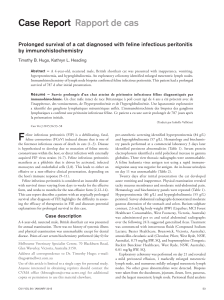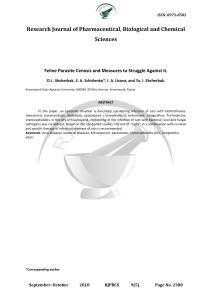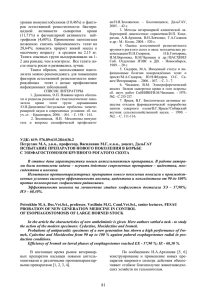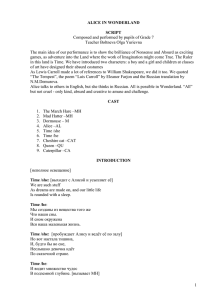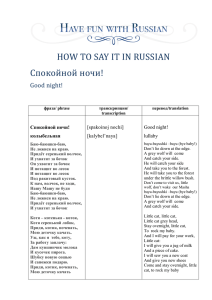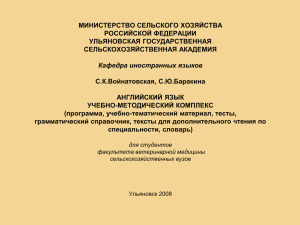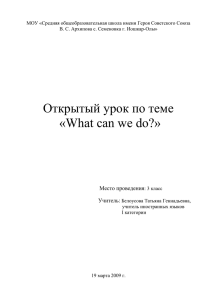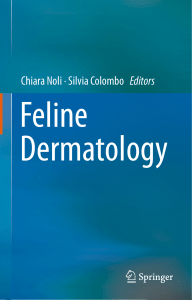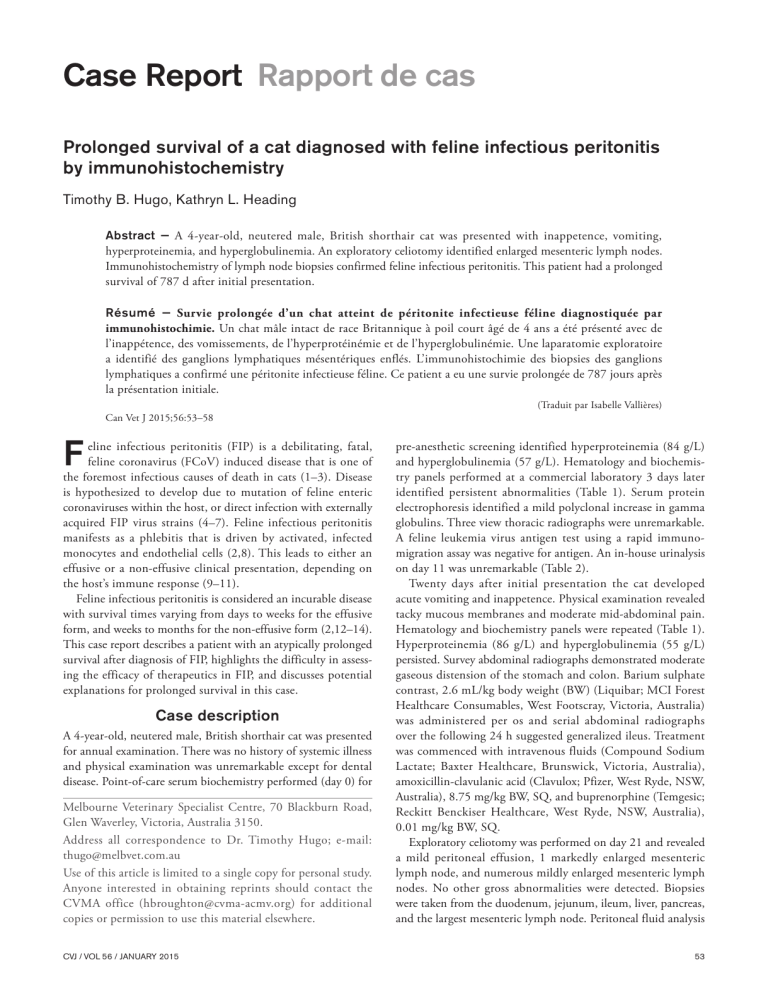
Case Report Rapport de cas Prolonged survival of a cat diagnosed with feline infectious peritonitis by immunohistochemistry Timothy B. Hugo, Kathryn L. Heading Abstract — A 4-year-old, neutered male, British shorthair cat was presented with inappetence, vomiting, hyperproteinemia, and hyperglobulinemia. An exploratory celiotomy identified enlarged mesenteric lymph nodes. Immunohistochemistry of lymph node biopsies confirmed feline infectious peritonitis. This patient had a prolonged survival of 787 d after initial presentation. Résumé — Survie prolongée d’un chat atteint de péritonite infectieuse féline diagnostiquée par immunohistochimie. Un chat mâle intact de race Britannique à poil court âgé de 4 ans a été présenté avec de l’inappétence, des vomissements, de l’hyperprotéinémie et de l’hyperglobulinémie. Une laparatomie exploratoire a identifié des ganglions lymphatiques mésentériques enflés. L’immunohistochimie des biopsies des ganglions lymphatiques a confirmé une péritonite infectieuse féline. Ce patient a eu une survie prolongée de 787 jours après la présentation initiale. Can Vet J 2015;56:53–58 F eline infectious peritonitis (FIP) is a debilitating, fatal, feline coronavirus (FCoV) induced disease that is one of the foremost infectious causes of death in cats (1–3). Disease is hypothesized to develop due to mutation of feline enteric coronaviruses within the host, or direct infection with externally acquired FIP virus strains (4–7). Feline infectious peritonitis manifests as a phlebitis that is driven by activated, infected monocytes and endothelial cells (2,8). This leads to either an effusive or a non-effusive clinical presentation, depending on the host’s immune response (9–11). Feline infectious peritonitis is considered an incurable disease with survival times varying from days to weeks for the effusive form, and weeks to months for the non-effusive form (2,12–14). This case report describes a patient with an atypically prolonged survival after diagnosis of FIP, highlights the difficulty in assessing the efficacy of therapeutics in FIP, and discusses potential explanations for prolonged survival in this case. Case description A 4-year-old, neutered male, British shorthair cat was presented for annual examination. There was no history of systemic illness and physical examination was unremarkable except for dental disease. Point-of-care serum biochemistry performed (day 0) for Melbourne Veterinary Specialist Centre, 70 Blackburn Road, Glen Waverley, Victoria, Australia 3150. Address all correspondence to Dr. Timothy Hugo; e-mail: [email protected] Use of this article is limited to a single copy for personal study. Anyone interested in obtaining reprints should contact the CVMA office ([email protected]) for additional copies or permission to use this material elsewhere. CVJ / VOL 56 / JANUARY 2015 (Traduit par Isabelle Vallières) pre-anesthetic screening identified hyperproteinemia (84 g/L) and hyperglobulinemia (57 g/L). Hematology and biochemistry panels performed at a commercial laboratory 3 days later identified persistent abnormalities (Table 1). Serum protein electrophoresis identified a mild polyclonal increase in gamma globulins. Three view thoracic radiographs were unremarkable. A feline leukemia virus antigen test using a rapid immunomigration assay was negative for antigen. An in-house urinalysis on day 11 was unremarkable (Table 2). Twenty days after initial presentation the cat developed acute vomiting and inappetence. Physical examination revealed tacky mucous membranes and moderate mid-abdominal pain. Hematology and biochemistry panels were repeated (Table 1). Hyperproteinemia (86 g/L) and hyperglobulinemia (55 g/L) persisted. Survey abdominal radiographs demonstrated moderate gaseous distension of the stomach and colon. Barium sulphate contrast, 2.6 mL/kg body weight (BW) (Liquibar; MCI Forest Healthcare Consumables, West Footscray, Victoria, Australia) was administered per os and serial abdominal radiographs over the following 24 h suggested generalized ileus. Treatment was commenced with intravenous fluids (Compound Sodium Lactate; Baxter Healthcare, Brunswick, Victoria, Australia), amoxicillin-clavulanic acid (Clavulox; Pfizer, West Ryde, NSW, Australia), 8.75 mg/kg BW, SQ, and buprenorphine (Temgesic; Reckitt Benckiser Healthcare, West Ryde, NSW, Australia), 0.01 mg/kg BW, SQ. Exploratory celiotomy was performed on day 21 and revealed a mild peritoneal effusion, 1 markedly enlarged mesenteric lymph node, and numerous mildly enlarged mesenteric lymph nodes. No other gross abnormalities were detected. Biopsies were taken from the duodenum, jejunum, ileum, liver, pancreas, and the largest mesenteric lymph node. Peritoneal fluid analysis 53 Table 1. Hematology and biochemistry results obtained during the 787-day survival period of a cat with feline infectious peritonitis Laboratory value (Reference range) R A P P O R T D E CA S 1012/L RCC 3 (5.00–10.00) Hemoglobin (80–150 g/L) Haematocrit (0.24–0.45 L/L) Reticulocytes (3 109/L, %) MCV (39–55 fL) MCH (13–17 pg/cell) MCHC (300–360 g/L) WCC 3 109/L (5.5–19.5) Neutrophils 3 109/L (2.5–12.5) Bands 3 109/L (, 0.4) Lymphocytes 3 109/L (1.5–7.0) Monocytes 3 109/L (, 0.9) Eosinophils 3 109/L (, 1.6) Bilirubin (2–10 mmol/L) Total Protein (56–80 g/L) Albumin (22–35 g/L) Globulin (28–48 g/L) ALT (5–80 U/L) ALP (5–80 U/L) GGT (1–10 U/L) Urea (5.4–10.7 mmol/L) Creatinine (70–160 mmol/L) Calcium (1.75–2.50 mmol/L) Cholesterol (1.9–3.9 mmol/L) AST (10–60 U/L) CK (50–300 U/L) Glucose (3.9–7.5 mmol/L) Phosphate (1.29–2.26 mmol/L) Sodium (147–156 mmol/L) Potassium (3.8–4.6 mmol/L) Chloride (115–123 mmol/L) Day 0 Day 3 Day 20 Day 166 Day 240 Day 611 Day 769 NA NA NA NA NA NA NA Increased NA NA NA NA NA ,2 84 27 57 19 26 NT 8.5 104 2.43 2.4 NT NT 5.44 1.35 NT NT NT 7.67 95 0.28 NT 36 12.0 342 20.9 11.9 0 6.9 1.3 0.8 1 90 30 60 24 12 ,1 9.2 108 2.38 2.2 19 116 5.1 1.46 156 4.7 125 10.10 119 0.35 NT 35 12.0 337 15.5 9.1 0 6.0 0.1 0.1 3 86 31 55 48 12 ,1 10.5 107 2.33 2.2 31 246 5.2 1.58 152 4.7 119 7.80 70 0.24 NT 31 9.0 294 35.1 23.9 0 9.8 0.3 1.1 81 89 24 65 44 13 1 4.5 139 2.29 4.6 35 99 7.7 1.78 156 4.9 124 11.10 108 0.33 NT 29 10.0 330 28.3 20.4 0 5.7 1.4 0.9 5 96 31 65 41 9 3 16.5 220 3.39 3.8 38 185 4.8 2.21 NT NT NT 6.60 60 0.19 , 7, , 0.1% 29 9.0 315 28.9 20.8 0.3 6.4 1.2 0.3 20 117 22 95 38 7 1 8 76 2.22 3.4 37 152 6.3 1.75 150 4.8 118 6.13 62 0.20 , 6 , 0.1% 32 10.0 310 26.0 19.8 0.3 5.2 0.5 0.3 2 97 25 72 27 7 2 7.7 64 2.16 3.5 36 244 7.7 1.72 152 4.7 121 ALP — alkaline phosphatase; ALT — alanine aminotransferase; AST — aspartate aminotransferase; CK — creatine kinase; GGT — gammaglutamyl transferase; MCH — mean corpuscular hemoglobin; MCHC — mean corpuscular hemoglobin concentration; MCV — mean corpuscular volume; NA — not available; NT — not tested; RCC — red cell count. was consistent with a modified transudate. The fluid had a protein of 30 g/L, a red blood cell count of 71 000 3 106/L, and a nucleated cell count of 4100 3 106/L, of which 50% were macrophages, 30% non-degenerate neutrophils, and 20% reactive mesothelial cells. All histopathology samples were assessed by a veterinary pathologist. Histopathology of intestinal biopsies demonstrated mild, diffuse lymphoplasmacytic enteritis with small numbers of neutrophils extending into the lamina propria. The hepatic histopathology demonstrated a mild, multifocal, neutrophilic pericholangitis. Lymph node biopsies showed increased numbers of viable and degenerate neutrophils extending into the surrounding adipose tissue and visceral peritoneum. Medullary sinusoids were markedly distended by increased numbers of plasma cells which extended into the mesentery. There were also multifocal histiocytic aggregates throughout the lymph node. Immunohistochemical staining was performed by Veterinary Pathology Diagnostic Services at the University of Sydney on all tissue samples using monoclonal antibody directed against the nucleocapsid of FCoV (15). All positive and negative quality controls were satisfactory. FCoV infected macrophages were detected in the lymphoid tissue, confirming a diagnosis of FIP. Virus was not detected in other tissues. For the first month post diagnosis the patient was treated with meloxicam (Metacam; Boehringer Ingelheim, North Ryde, 54 NSW, Australia), 0.05 mg/kg BW, PO, q24h, and metronidazole (Metrogyl; Alphapharm, Millers Point, NSW, Australia), 10 mg/kg BW, PO, q12h. Cephalexin (Rilexine; Virbac, Regents Park, NSW, Australia), 30 mg/kg BW, PO, q12h was administered for 7 days, followed by an injection of cefovecin (Convenia; Pfizer, West Ryde, NSW, Australia), 8 mg/kg BW, SQ for pyrexia, a poor appetite and a suspected surgical wound infection. Meloxicam treatment was continued until day 119 due to intermittent inappetence and a soft tissue injury of the left hock that occurred on day 86. An acute episode of upper respiratory disease characterized by sneezing, left ocular discharge and blepharospasm developed on day 79 which was managed with doxycycline (Vibravet; Pfizer, West Ryde, NSW, Australia), 5 mg/kg BW, PO, q12h for 21 d. No further medications were administered for 4 mo, apart from amoxicillin-clavulanic acid, 12.5 mg/kg BW, PO, q12h for feline lower urinary tract disease (days 146 to 153) and doxycycline, 5 mg/kg BW, PO, q12h for another suspected upper respiratory tract infection (days 226 to 241). Urinalysis and culture were performed on day 147 (Table 2). The urine culture was negative, but significant proteinuria and biliru­ binuria were identified. Hematology and biochemistry panels were performed on day 166 (Table 1). The most significant abnormalities included a leukocytosis, 35.1 3 109/L, characterized by a neutrophilia, 23.9 3 109/L and lymphocytosis, CVJ / VOL 56 / JANUARY 2015 Table 2. Urinalysis during the 787-day survival period of a cat with feline infectious peritonitis Laboratory value Day 11 (IH) Day 147 (EX) a Day 769 (EX) 1.045 6.5 111 2 2 111 NSF NSF NSF 1.058 7 111 2 2 11 ,5 ,5 None 1.053 7 111 2 2 2 ,5 ,5 None NT NT NT Reference value = 0 to 5; EX — external laboratory; HPF — high power field; IH — in house; NSF — no significant findings; RBC — red blood cell; USG — urine specific gravity; WBC — white blood cell; NT — not tested. 9.8 3 109/L, hyperproteinemia, 89 g/L, hyperglobulinemia, 65 g/L, and hyperbilirubinemia, 81mmol/L. Further investigation was recommended but declined due to FIP status. The patient was presented again on day 240 with inappetence and vomiting. Palpation revealed abdominal pain and a mid-abdominal mass. Hematology and biochemistry panels were performed (Table 1). Significant abnormalities included a leukocytosis, 28 3 109/L, characterized by a neutrophilia, 20.4 3 109/L, and monocytosis, 1.4 3 109/L, hyperproteinemia, 96 g/L, hyperglobulinemia, 65 g/L, increased urea, 16.5 mmol/L, and increased creatinine, 220 mmol/L. The patient was treated with tramadol hydrochloride (Bova Compounding, Caringbah, NSW, Australia), 1 mg/kg BW, PO, q12h, metoclopramide (Maxolon; Valeant Pharmaceuticals, Port Melbourne, VIC, Australia), 1 mg/kg BW, PO, q8h for 4 d and a bland diet. Clinical signs improved within 7 d and tramadol was continued for a further 13 mo (1 mg/kg BW, PO, q12h from days 242 to 345, 1 mg/kg BW, PO, q24h from days 345 to 402, 1 mg/kg BW, PO every second day from days 402 to 634). On day 611 the patient was presented for weight loss and dark-colored urine. Hematology, biochemistry, and urinalysis were performed (Tables 1 and 2). Significant abnormalities included a non-regenerative anemia with a hemoglobin of 60 g/L and hematocrit of 0.19 L/L, a leukocytosis, 28.9 3 109/L, characterized by a neutrophilia, 20.8 3 109/L, and monocytosis, 1.2 3 109/L, hyperproteinemia, 117 g/L, hyperglobulinemia, 95 g/L, hyperbilirubinemia, 20 mmol/L, proteinuria, and bilirubinuria. Abdominal sonography identified a heterogenous mass within the right side of the liver. Further diagnostic investigation was recommended but declined. Treatment was commenced on day 635 with prednisolone (Pred-X; Apex Laboratories, Somersby, NSW, Australia), 1 mg/kg BW, PO, q24h until day 696, followed by 0.5 mg/kg BW, PO, q24h ongoing and metronidazole, 10 mg/kg BW, PO, q12h (days 635 to 663). On day 769 the cat was presented with a grade III/VI left systolic heart murmur, abdominal distension with a fluid wave and palpably enlarged kidneys. Hematology, biochemistry, and urinalysis were performed (Tables 1 and 2). Similar significant abnormalities were identified; however, the hyperbilirubinemia and bilirubinuria had resolved. Over the following 5 d the patient developed respiratory distress, a pleural effusion, and CVJ / VOL 56 / JANUARY 2015 Day 611 (EX) CA S E R E P O R T USG . 1.045 1.061 pH 6 7.5 Protein 2 11 Ketones 2 2 Glucose 2 2 Bilirubin 2 11 RBC cellsa/HPF NSF 40 WBC cellsa/HPF NSF ,5 Other findings NSF Occasional struvite crystals Culture NT Negative Day 604 (IH) increasing abdominal distension. The cat was euthanized on day 787 (766 d after surgery). Discussion The case presented here describes the longest survival of a cat confirmed with FIP by gold standard diagnosis. Gold standard diagnosis involves the use of either immunofluorescence or immunohistochemistry on appropriate fluid or tissue samples, respectively (2). In this case, immunohistochemistry was used to identify FCoV antigen within macrophages in the abdominal lymph node. A positive result by either of these gold standard tests is 100% predictive of FIP, confirming the diagnosis in this patient (16,17). In addition to compatible immunohistochemistry results, this patient also displayed clinicopathological abnormalities commonly reported in FIP, including a non-regenerative anemia, neutrophilic leukocytosis, hyperproteinemia, and hyperglobulinemia (18,19). The non-regenerative anemia in patients with FIP is due to chronic disease and in this case developed during the final stages of survival. A neutrophilic leukocytosis was reported at most time points in this patient and is due to both stress and inflammation. Persistent increases in both total protein and globulin levels were identified at all time points in this patient. The hyperglobulinemia of FIP is predominantly due to a polyclonal increase in gamma globulins, as was demonstrated by protein electrophoresis in this case (20,21). This increase in gamma globulins is suggested to be due to a combination of FCoV antibody titres, non-specific antibody globulins and complement factors (2,19). Hyperbilirubinemia is also reported in association with FIP, identified on days 166 and 611 in this patient (2). In a previous study, 36.1% of patients with FIP exhibited hyperbilirubinemia at initial presentation, which increased to 89.3% just before death (22). In most cases hyperbilirubinemia develops due to microhemorrhage and extravascular destruction induced by vasculitis and disseminated intravascular coagulation (DIC) (2). Additional contributing factors can include a secondary immune-mediated hemolytic anemia, hepatocellular necrosis, or sepsis induced by immune dysfunction (14,22,23). In some patients where these factors are excluded, the mechanism of 55 R A P P O R T D E CA S hyperbilirubinemia is speculated to be due to FIP-induced compromised bilirubin metabolism and excretion (23). In this case, although a hepatic lesion was identified sonographically late in the course of disease, the absence of hepatic enzyme abnormalities raises some doubt as to the significance of this lesion and its relation to the hyperbilirubinemia. There were also minimal physical examination or laboratory abnormalities supportive of an immune-mediated hemolytic anemia, sepsis, or DIC in this case. Further laboratory testing and hepatic biopsies would have been required to investigate these possibilities. The most consistent abnormality on serial urinalysis was proteinuria, identified from day 147 onwards. In this case, it is probable that physiological factors, such as pyrexia and stress, made small contributions to this abnormality. There was no evidence of pre-renal causes, such as hemolysis, muscle damage, or neoplasia. Furthermore, urinary sediment was inactive, thereby excluding post-renal causes of proteinuria. Feline infectious peritonitis is reported to be a cause of renal proteinuria and is suspected to be the dominant factor contributing to the proteinuria in this case (24). Causative lesions may have included pyogranulomatous nephritis or an immune-complex nephritis secondary to FIP. Feline infectious peritonitis is considered to be an incurable disease with no effective therapeutic regimens (2,12). There are various reports of substances inducing remission, but such claims are often fraught with a lack of confirmatory “gold-standard” tests (2). The absence of a confirmed diagnosis in many reported cases may have contributed to large variation in both the proposed efficacy of therapeutics and documented survival times for cases of FIP (2). Therapeutics which may have influenced both the quality of life and survival of the patient described here include meloxicam, prednisolone, and tramadol hydrochloride. Antiinflammatory drugs have long been recommended in the management of cases of FIP to target virus-induced proinflammatory cytokines and inflammatory mediators that exacerbate the vasculitis (25). Corticosteroids, specifically prednisolone, are most commonly recommended for this purpose; however, there have been no placebo-controlled studies evaluating its efficacy, or that of non-steroidal anti-inflammatory drugs, such as meloxicam (25). Two controlled studies evaluating feline interferon-omega and propentofylline in the treatment of FIP utilized corticosteroid treatment in both the placebo and treatment groups. Interestingly the median survival time of patients in the placebo groups were only 8 d and 7.5 d, respectively (12,26). These findings have added significant doubt to the theorised efficacy of corticosteroids. In the present case, prednisolone and meloxicam were administered for only 4 mo and 3 mo, respectively. These durations are relatively short in the context of the overall survival time of this patient and therefore the impact of these therapeutics is considered limited or noncontributory in this case. Supportive therapy was also provided with tramadol hydrochloride for 13 mo after diagnosis. Tramadol is a centrally acting analgesic with a complex mechanism of action that involves both interactions with opiate receptors and inhibition of norepinephrine and serotonin reuptake in descending inhibitory pathways 56 (27–29). There are limited studies on its pharmacokinetics and duration of action in cats. One study demonstrated that a dose of 2 to 4 mg/kg BW was required to induce and sustain analgesia, and that administration of 4 mg/kg BW every 6 h would maintain analgesia close to the maximal effect of tramadol (30). Based on these results, the dosage and frequency of tramadol administration used in this patient (1 mg/kg BW, q12h to q48h) would be expected to have had minimal analgesic effect. Interestingly, tramadol has also been reported to inhibit different types of experimental inflammation in rats (31). Tramadol administration resulted in a significant reduction in inflammatory edema but it did not alter the number of polymorphonuclear leukocytes in exudates, or the mobility and chemotaxis of macrophages (31). Other studies have also documented that the mechanism for this anti-inflammatory effect is not directly related to the production of prostaglandins and it has been proposed to result from an anti-edema effect mediated via similar pathways responsible for its analgesia (32). It is possible that anti-inflammatory or anti-edema effects of tramadol may also exist in cats and thus may have contributed to this patient’s extended survival time. It is accepted that the anticipated survival times of cats with FIP vary from days to weeks for the effusive form, and weeks to months for the non-effusive form (13,14). Studies reporting survival times of cats with naturally occurring FIP in which gold-standard diagnosis was obtained are limited. One prospective study of 37 cats with confirmed FIP assessing the efficacy of feline interferon omega reported a median survival of 9 d, with the longest survival time reported to be 200 d (12). Another study investigating the efficacy of propentofylline in a group of 29 cats diagnosed with FIP documented survival times of between 4 and 36 d (26). Other studies with compatible histopathology, but without a “gold standard” diagnosis include a retrospective study of 51 cats diagnosed by compatible histopathology and positive detection of FCoV by reverse-transcriptase polymerase chain reaction of samples that included body effusions; nasal, conjunctival, tonsilar, and rectal swabs; and tissue from organs collected at necropsy (22). In this study, survival ranged from 1 to 477 d (22). Another study involving 12 cats reported survival times between 2 d to over 2 y (33). However, histopathology was not performed in any of the 4 cats that survived over 2 y, and of patients with compatible histopathology, the longest reported survival was 5 mo (33). In addition to the aforementioned studies, earlier reports describe variable survival times in cats with clinical (unconfirmed) diagnoses of FIP. Weiss (34) reported a survival in excess of 8 mo in 2 cats experimentally inoculated with FIP virus (DF2 strain) at highly lethal amounts (200 LD100). One paper describes an FIP-infected cat treated with prednisolone and phenylalanine mustard that appeared to respond for 9 mo, after which it developed a myeloproliferative disorder and died (35). In another paper 2 cats with suspected FIP that were treated with tylosin and prednisolone were still alive at 180 and 210 d at last follow-up (36). Another study of 29 cats with suspected FIP and a variety of treatments reported a survival of more than 3 y in some (37). Additionally, a recent review CVJ / VOL 56 / JANUARY 2015 Acknowledgments We are grateful to Lauren Paterson and all the staff at Reservoir Veterinary Clinic. CVJ References 1. Rohrbach BW, Legendre AM, Baldwin CS, Lein DH, Reed WM, Wilson RB. Epidemiology of feline infectious peritonitis among cats examined at veterinary medical teaching hospitals. J Am Vet Med Assoc 2001;218:1111–1115. 2. Pedersen NC. A review of feline infectious peritonitis virus infection: 1963–2008. J Feline Med Surg 2009;11:225–258. 3. Kipar AK, Meli ML, Baptiste KE, Bowker LJ, Lutz H. Sites of feline coronavirus persistence in healthy cats. J Gen Virol 2010;91: 1698–1707. 4. Poland AM, Vennema H, Foley JE, Pedersen NC. Two related strains of feline infectious peritonitis virus isolated from immunocompromised cats infected with a feline enteric coronavirus. J Clin Microbiol 1996; 34:3180–3184. 5. Vennema H, Poland A, Foley J, Pedersen NC. Feline infectious peritonitis viruses arise by mutation from endemic feline enteric coronaviruses. Virology 1998;243:150–157. CVJ / VOL 56 / JANUARY 2015 6. Brown MA, Troyer JL, Pecon-Slattery J, Roelke ME, O’Brien SJ. Genetics and pathogenesis of feline infectious peritonitis virus. Emerg Infect Dis 2009;15:1445–1452. 7. Pedersen NC, Lin H, Dodd KA, Pesavento PA. Significance of coronavirus mutants in feces and diseased tissues of cats suffering from feline infectious peritonitis. Viruses 2009;1:166–184. 8. Kipar A, May H, Menger S, Weber M, Leukert W, Reinacher M. Morphological features and development of granulomatous vasculitis in feline infectious peritonitis. Vet Pathol 2005;42:321–330. 9. Wolfe LG, Griesemer RA. Feline infectious peritonitis. Pathol Vet 1966;3:255–270. 10. Montali RJ, Strandberg JD. Extraperitoneal lesions in feline infectious peritonitis. Vet Pathol 1972;9:109–121. 11. Pedersen NC. Feline infectious peritonitis. Something old, something new. Feline Pract 1976;6:42–51. 12. Ritz S, Egberink H, Hartmann K. Effect of feline interferon-omega on the survival time and quality of life of cats with feline infectious peritonitis. J Vet Intern Med 2007;21:1193–1197. 13. Legendre AM, Bartges JW. Effect of polyprenyl immunistimulant on the survival times of three cats with the dry form of feline infectious peritonitis. J Feline Med Surg 2009;11:624–626. 14. Addie DD. Feline coronavirus infections. In: Greene CE, ed. Infectious Diseases of the Dog and Cat. 4th ed. St. Louis, Missouri: Saunders-Elsevier, 2012:92–108. 15. Worthing KA, Wigney DI, Dhand NK, et al. Risk factors for feline infectious peritonitis in Australian cats. J Feline Med Surg 2012;14:405–412. 16. Tammer R, Evensen O, Lutz H, Reinacher M. Immunohistological demonstration of feline infectious peritonitis virus antigen in paraffinembedded tissues using feline ascites or murine monoclonal antibodies. Vet Immunol Immunopathol 1995;49:177–182. 17. Hartmann K, Binder C, Hirschberger J, et al. Comparison of different tests to diagnose feline infectious peritonitis. J Vet Intern Med 2003;17: 781–790. 18. Sparkes AH, Gruffydd-Jones TJ, Harbour DA. Feline infectious peritonitis: A review of clinicopathological changes in 65 cases, and a critical assessment of their diagnostic value. Vet Rec 1991;129:209–212. 19. Paltrinieri A, Cammarata MP, Cammarata G, Comazzi S. Some aspects of humoral and cellular immunity in naturally occurring feline infectious peritonitis. Vet Immunol Immunopathol 1998;65:205–220. 20. Paltrinieri S, Grieco V, Comazzi S, Cammarata MP. Laboratory profiles in cats with different pathological and immunohistochemical findings due to feline infectious peritonitis (FIP). J Feline Med Surg 2001;3:149–159. 21. Paltrinieri S, Comazzi S, Spagnolo V, Giordano A. Laboratory changes consistent with feline infectious peritonitis in cats with multicat environments. J Vet Med A 2002;49:503–510. 22. Tsai H, Chueh L, Lin C. Clinicopathological findings and disease staging of feline infectious peritonitis: 51 cases from 2003 to 2009 in Taiwan. J Feline Med Surg 2011;13:74–80. 23. Hartmann K. Feline infectious peritonitis. Vet Clin North Am Small Animal Pract 2005;35:39–79. 24. Harley L, Langston C. Proteinuria in dogs and cats. Can Vet J 2012;53:631–638. 25. German A. Update on feline infectious peritonitis. In Pract 2012;34: 282–291. 26. Fisher Y, Ritz S, Weber K, Sauter-Louis C, Hartmann K. Randomized, placebo controlled study of the effect of propentofylline on survival time and quality of life of cats with feline infectious peritonitis. J Vet Intern Med 2011;25:1270–1276. 27. Kayser V, Besson JN, Guilbaud G. Evidence of noradrenergic component in the antinociceptive effect of the analgesic agent tramadol in an animal model of clinical pain, the arthritic rat. Eur J Pharmacol 1992;224:83–88. 28. Raffa RB, Friederichs E, Reimann W, Shank RP, Codd EE, Vaught JL. Opioid and nonopioid components independently contribute to the mechanism of action of tramadol, an “atypical” opioid analgesic. J Pharmacol Exp Ther 1992;260:275–285. 29. Scott LJ, Perry MP. Tramadol: A review of its use in perioperative pain. Drugs 2000;60:139–176. 30. Pypendop BH, Siao KT, Ilkiw JE. Effects of tramadol hydrochloride on the thermal threshold in cats. Am J Vet Res 2009;70:1465–1470. 31. Bianchi M, Rossoni G, Sacerdote P, Panerai AE. Effects of tramadol on experimental inflammation. Fundam Clin Pharmacol 1999;13:220–225. 32. Buccellati C, Sala A, Ballerio R, Bianchi M. Tramadol anti-inflammatory activity is not related to a direct inhibitory action on prostaglandin endoperoxide synthases. Eur J Pain 2000;4:413–415. 57 CA S E R E P O R T by Pedersen (2) anecdotally states that some cats have achieved remission without treatment. Interestingly, in addition to these, a study describing the benefit of polyprenyl immunostimulant on survival in 3 cats with non-effusive FIP has also documented prolonged survival times comparable to the patient herein (13). The distribution of pathology in all 3 cats was confined to the mesenteric lymph nodes, with evidence of granulomatous to pyogranulomatous lymphadenitis identified by cytology or histopathology (13). Pathology involving other organs was not identified. These findings are similar to those of the cat presented here. Of the 3 cats, survival times ranged from 14 mo to greater than 27 mo (13). However, only 1 of the 3 cats had a confirmed “gold standard” diagnosis using immunohistochemistry, and this cat was alive at 25 mo after diagnosis; the last reported communication. In the remaining 2 cats the diagnosis was made on serology, biochemistry, and histopathology or cytological findings consistent with FIP. The author proposes that confinement of FCoV within the mesenteric lymph nodes may explain the possibility of a lower pathogenic form of FIP infection in the present case and the other 3 cats with an improved survival time. This prolonged survival may therefore occur irrespective of medications administered. To the authors’ knowledge, the patient of this report demonstrates the longest reported survival of 787 d from first presentation for a case of FIP, in which diagnosis was confirmed with either immunofluorescence or immunohistochemistry. Further diagnostics or necropsy was declined at the time of euthanasia and, whilst the assumption is that this patient developed fulminating signs of FIP, this was not confirmed. It is possible that the patient may have developed a concurrent disease process such as congestive heart failure or neoplasia, responsible for the respiratory distress and body cavity effusions. The variable survival time in patients with FIP, such as this one, emphasize the importance of performing controlled clinical trials in the assessment of potential therapeutics. Additionally, the author proposes that a less pathogenic form of FIP may exist for which the prognosis is more favorable and may further compound the difficulties in assessing therapeutics. R A P P O R T D E CA S 33. Ishida T, Shibanai A, Tanaka S, Uchida K, Mochizuki M. Use of recombinant feline interferon and glucocorticoid in the treatment of feline infectious peritonitis. J Feline Med Surg 2004;6:107–109. 34. Weiss RC, Cox NR, Oostrom-Ram T. Effect of interferon or Propionibacterium acnes on the course of experimentally induced feline infectious peritonitis in specific-pathogen-free and random-source cats. Am J Vet Res 1990;51:726–733. 35. Madewell BR, Crow SE, Nickerson TR. Infectious peritonitis in a cat that subsequently developed a myeloproliferative disorder. J Am Vet Med Assoc 1978;172:169–172. 36. Colgrove DJ, Parker AJ. Feline infectious peritonitis. J Small Anim Pract 1971;12:225–232. 37. Bölcskei A, Bilkei G. Langzeitstudie über FIP-verdächtige katzen. Tierärztl Umsch 1995;50:721–728. Book Review Compte rendu de livre The Cat Whisperer: Why cats do what they do and how to get them to do what you want Nagelschneider M. Bantam Books, New York, USA. 2013. 310 pp. ISBN 978-0-553-80785-1. $29.95. A s a practicing small animal veterinarian, I have been faced all too many times with the emotional rollercoaster that is feline inappropriate urination. This, and other difficult feline behavioral issues made me interested in reading Ms. Nagelschneider’s book, “The Cat Whisperer.” The book starts by providing insight into the author, and how she became involved in the field of feline behavior. This is followed by sections on introducing (or reintroducing) cats to each other, evaluating the cat’s territory, and a discussion of some of the health problems that can cause behavioral issues. Finally, there are chapters on feline aggression, inappropriate elimination, marking, excessive meowing, destructive behaviors, and compulsive behaviors. Over-all, I was quite pleased with the book. I felt that Ms. Nagelschneider’s approaches to behavior issues make a lot of sense. I appreciated that she consistently reminds readers of the need to have cats examined by a veterinarian early in the process so rule out possible illnesses or injuries that might be at the root of the problem. She also touches on a personal soapbox of mine, which is declawing. She explains in great detail how and why this is a negative procedure for cats, which should be avoided. The author worked as a Veterinary Assistant and a Veterinary Technician for a number of years before she began her work as a cat behaviorist full time. Ms. Nagelschnerder emphasizes that cats don’t have an “agenda” with their behavioral issues, and strongly recommends avoiding anthropomorphism in these situations. This is an important recommendation, given that dealing with behavior problems can be difficult for owners, especially if the owner believes that the cat is somehow doing it on purpose. Throughout the course of the book, the reader learns to recognize patterns of mistakes that human caregivers make, which lead to conflict between cats and their owners, as well as between cats in the household. This ultimately helps the reader recognize 58 how the cat’s environment shapes their behavior, and how simple changes can be made to improve the cat’s quality of life and avert the problematic behavior. I do, however, have a few minor complaints about the book. The introductory chapter is excessively long in describing how the author befriended feral cats as a child by feeding them tuna fish sandwiches. I felt that this could have been much shorter. Several times, Ms. Nagelschneider recommends free-feeding cats. She asserts that food scarcity causes stress in cats, and may lead to conflict between cats, and anxiety that can lead to behavior problems. While I appreciate that feeding only one or two meals a day may be stressful for a cat, and that maybe feeding many small meals throughout the day would be better, I strongly disagree with her belief that most cats self-regulate if free-fed. This may be anecdotal, but most cats I know do not self-regulate, and unless their feedings are carefully controlled, they have a tendency to become overweight. To be fair, she does mention what to do if a cat doesn’t self-regulate, but I feel that the amount of time spent recommending free-feeding is out of proportion to the number of cats who can handle it. Finally, I found the Feline Aggression chapter needed to be massaged a bit, editing-wise. The problem is that there are many sub-types of aggression and then further sub-types of several of these. The chapter became confusing, as the author would lump different types of aggression together when presenting the CAT plans for them, and it became difficult to differentiate which recommendations were for which type of aggression. Hopefully this issue can be remedied in later editions of the book. In conclusion, I do recommend this book, both for veterinarians and clients. I think that it contains valuable insight into why cats do what they do, and it gives readers the tools to recognize what might be causing stress in a cat’s life, how that might be causing behavioral issue(s), and how these stressors can be avoided or re-configured to keep everyone happy. Ms. Nagelschneider works hard to show people that there are many options aside from euthanasia to deal with even the most frustrating of behaviors, and I think she succeeds in giving cats a fair shake. Reviewed by Teresa Bousquet, DVM, Park Veterinary Centre, 101 Broadway Blvd, Sherwood Park, Alberta T8H 2A8. CVJ / VOL 56 / JANUARY 2015
